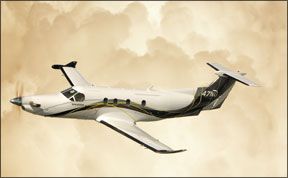Wh
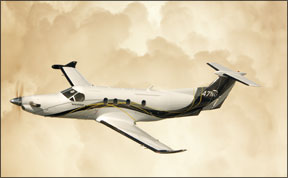
because availability might be questionable and still carry on if something broke out in the bush.
For decades, Switzerland-based Pilatus has built airplanes to meet the demands of armed services throughout the world. The PC-12 continues the tradition, with a number of air forces (its the U-28A for the U.S. Air Force), as we’ll as law enforcement organizations operating them either as light transports or for surveillance as the PC-12 Spectre.
Nevertheless, the launch customer was the Royal Flying Doctor Service of Australia for its work in the extremes of the outback. With single-engine IFR certification under FAR Part 135 available, the PC-12 has also proven popular with charter operators.
To the minor amazement of its makers, once in service, the PC-12 proved to be popular with individuals who wanted to carry the family, the bicycles and most of the contents of their vacation cottage and then whistle off at 270 knots. Pilatus found that those folks were willing to pay the roughly $3.5 million price of the average equipped PC-12. As a result, more than 400 of the 700-plus PC-12s delivered to date have come into the western hemisphere through the Pilatus center at Denver Metro (formerly Jeffco) Airport in Broomfield, Colorado.
Smart System Design
The walkaround shows that despite the luxurious leather inside, the PC-12 was designed to work for its living in unpleasant conditions. Yet, with pressurization and retractable gear, the design philosophy is clearly different than the extreme simplicity of the other back country turboprop in production, the Cessna Caravan. At 60 PSI, the oversize tires carry low pressure for operation on unimproved runways.
Virtually all of the systems, as we’ll as the engine, can be accessed via doors or hatches that unlatch and swing open easily-only one access port has to be unscrewed during a 100-hour inspection. Lubrication oil quantity is checked via a sight gauge, reducing the chance of engine failure because someone forgot to
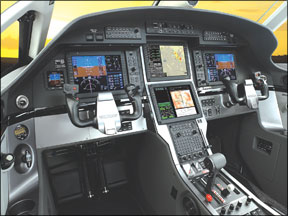
replace the oil dipstick correctly. The oil filler cap has a vertical stripe of paint on it to quickly indicate if its correctly screwed on and another sight gauge shows hydraulic fluid quantity for the landing gear and brakes.
All spaces where lines or cables run are painted white so that leaks will be obvious as we’ll as cha fed or flaked pieces of cable or other materials. Some access hatches are hinged to open downward and designed so that they will catch leaks and make them immediately apparent. Should the exterior fuel shutoff be activated during maintenance, a rod protrudes from the side of the aircraft, making it impossible to close the access hatch.
For occupant protection in an accident, no hydraulic or fuel lines penetrate the pressure vessel and the 406 gallons of fuel (402 gallons usable) in the wings is as far outboard as possible, with the exception of putting it in tip tanks. We suspect designing that 53-foot-4-inch span wing to carry the sheer volume of fuel necessary to give the PC-12 its impressive endurance had to be a major challenge.
The upside is that it was done in a fashion that fuel burn doesnt affect the aircrafts center of gravity; the downside is that there’s fuel all the way to the leading edge, so its only protected by a deicer boot and the leading edge aluminum in the event of a crash. When we inquired, Pilatus pointed out that the wing skin is made of stiffened clad aluminum alloy, riveted to the spar and ribs. The PC-12 does not have easily punctured fuel tanks and has never experienced a fuel leak as a result of minor wing damage or a fire due to major wing damage.
Fuel balancing is automated, so the pilot doesnt have to mess with tank selection or take any action unless the system should fail or a line person fills one tank much more than the other.
The PC-12 is approved for flight into known icing. The deicer boots are faired smoothly into the wing and horizontal stabilizer and all skins are of the smoothness weve come to expect of the faster turboprops and jets. The engine cowling and intake ducting is all composite, allowing for the subtle curves needed to minimize loss of power when the inertial separator must be used in icing conditions.
The 53-by 52-inch aft cargo door is even bigger than the huge opening on a Cessna Caravan. Its hinged to open vertically hydraulically, although it close via an electric motor and can also be operated manually. The latching mechanism for it and the main cabin door is easy to operate and the telltales showing the position of the latching pins were obvious and easy to read. A forklift can approach the fuselage at a 90-degree angle. An
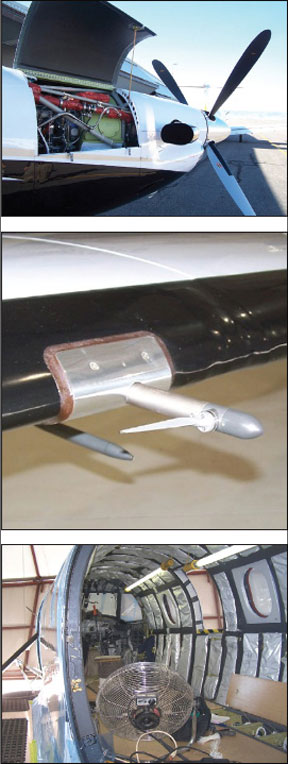
optional cargo kit installs Teflon-coated rails that increase the maximum weight per square foot on the floor and allow the cargo to be slid easily to where its to be tied down. There are slots allowing a fuselage-wide and tall cargo net to be placed at intermediate points in the cabin so as to turn the airplane into a combination cargo and people hauler. A T-tail was chosen partially to avoid damage by forklift drivers and to minimize pitch changes with power changes.
The GPU plug is in the far aft fuselage, we’ll away from the prop and is canted aft 45 degrees so that if the pilot taxies away without unplugging, the GPU disconnects without damaging anything. Also, small grounding tabs placed near the fuel fillers mean that line crew are less likely to do damage should they drive a fuel truck away with the grounding line still attached. The trailing edge of the rudder is blunt and reinforced, rather than pointed, to reduce the risk of damage in the field. The radar dish is on the right wing, where its drag helps with P factor. We noticed a number of small, red dots at various extremities of the airframe. They are points for laser measurement to assure the airframe is true during manufacturing and to determine whether turbulence or other excitement has deformed it.
Systems
Flight controls are cable driven, although there are pushrods in a portion of the aileron system. With the long-span flaps needed to keep stall speeds low, the ailerons are relatively small and Pilatus did not add spoilers for roll control, as did Cessna and Socata with their turboprops.
After some complaints about heavy ailerons, Pilatus installed anti-servo tabs on the ailerons, which, combined with the third generation of winglet, delivered acceptable roll forces and response, nicely harmonized with pitch and rudder forces and an aileron/rudder interconnect. Max flap travel of the semi-Fowler flaps is 40 degrees. In flight, that allowed for a dramatically steep rate of descent at 85 KIAS, something military operators like when ground fire is a possibility.
There are angle-of-attack vanes on each wing, providing information to dual AOA systems that drive a stick shaker and pusher. Stalls are prohibited, as the airplane could not meet the certification requirements regarding maximum roll-off at the stall break with full flaps and full power. It also means that angle of attack is displayed on the flight director, making holding precisely the right speed for a given landing weight easy.
Up front, a 1605-SHP Pratt and Whitney PT6A-67B spins a four-blade, full-feathering Hartzell prop. The engine is derated to 1200 SHP for five minutes on takeoff and 1000 SHP for continuous operation. A boost in thermodynamic SHP to 1744 is in the works with a -67P engine in 2008, which will allow the 1000 SHP to be developed to higher altitudes. We were told it should boost cruise 10 to 13 knots, allowing 280 knots at FL240.
Max gross weight for the PC-12 is 10,495 pounds, with max takeoff at 10,450 pounds. The airplane we flew weighed 6474 pounds empty, giving a useful load of 4021 pounds. With all 2704 pounds of fuel aboard, 1317 pounds may be carried in the cabin, or six 200 pounders and more than 100 pounds of baggage. For the pilot-plus-four range question used for evaluating VLJs and single-engine turboprops, the answer for the PC-12 is that a pilot plus five can still carry full fuel and go 1500 nautical miles at max speed cruise with NBAA reserves, meaning it can miss the approach and go to an alternate 100 miles away.
The zero-fuel weight is 9040 pounds, which, on the airplane we reviewed, allowed a hefty 2566 pounds in the cabin. In sample loading problems, we found that with just two people up front, the airplane was near the forward CG limit. Keeping just the pilot aboard and then loading the maximum 400 pounds in the aft baggage area (behind the rear seats) and then 500 pounds in the back end of the cabin, moved
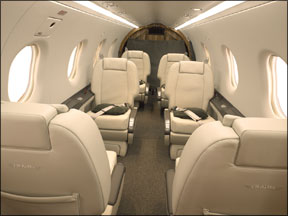
the CG to near the aft limit, indicating what should be a satisfactory CG range in service. Max landing weight is 9920 pounds, so 575 pounds of fuel have to be burned off following a max gross launch. Weight and balance and performance data can be downloaded onto a PDA, for ease in flight planning.
Cabin Amenities
The PC-12s cabin is slightly larger than a King Air 200, with the extra width noticeable. Seats recline and swivel and have three-point restraints. There’s a quite private potty opposite the airstair door.
The cockpit is comfortable for virtually any size pilot. The step past the console is not particularly difficult and while we would prefer a side stick from a crashworthiness perspective, the control yoke slides out of the panel so there’s no column to take up floor space. The crew seats adjust vertically and horizontally, tilt, have lumbar support and four-point restraints. One unusual feature in an airplane this size is adjustable rudder pedals, which allows the pilot to obtain the eye position recommended by lining up two small balls on top of the magnetic compass.
The airplane we flew had a Honeywell EFIS, autopilot and copilot EFIS. Pilatus is currently certifying a fully-integrated Honeywell Primus Apex glass panel system with two PFDs and MFDs that will automatically handle many of the items currently taken care of by the pilot, such as climate control and setting the pressurization.
Although we don’t like switches on the overhead panels, Pilatus has kept these to a minimum and there will be fewer when the Apex system is installed, so pilots can operate switches without looking through bi-focals. Further, the switches are far enough inboard as to not be an impact hazard in a crash and much of the airplanes electrical system is automated.
The panel is otherwise conventional, although trim is all-electric, with no manual reversion. Pitch and roll trim are on a toggle on the control wheel while rudder trim is conveniently placed where needed, on the forward side of the throttle. In this high-horsepower single, power changes require some rudder trim change. Power control is single-lever as in a jet; RPM is not selected by the pilot.
The standby bus is activated to carry out the chores needed prior to start up and to light off the engine. Startup is conventional for a turboprop–hit the starter button, then introduce fuel at about 14 percent RPM and monitor to assure the start stays within temperature parameters. Once the engine is running, the two
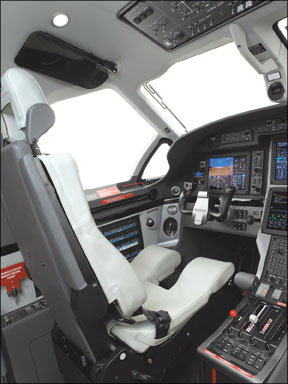
generators are turned on as are the two avionics master switches. The electrical system is a 28-volt dual-bus system with one or an optional second battery. Failure of one generator alerts the pilot, but load shedding is automatic.
Taking OffTaxiing is smooth with positive nosewheel steering, although you have to pay attention to keep your toes low on the pedals and not inadvertently ride the brakes during taxi and takeoff. Pre-takeoff checks are brief and include checking the stick shaker and pusher, setting takeoff trim, which includes a significant amount of right rudder and assuring the annunciator panel is dark. On virtually all takeoffs, setting power for takeoff consists of pushing the power lever forward to the stop-no twiddling to avoid overshooting maximum torque. The nosewheel is raised at about 80 knots with moderate backpressure.
Its almost impossible to tell when the airplane leaves the ground because the long stroke trailing beam gear is so smooth that you get the impression of simply being in a highspeed elevator. Short field takeoff is with 30 degrees of flaps and requires about 1650 feet of runway, clearing a 50-foot obstacle in about 2650 feet on a standard day at sea level. With the significant de-rating of the engine, the full 1200 SHP is available for takeoff at high elevations, so the performance becomes more impressive at airports in the mountains.
Vy is initially 120 KIAS and generates more than 1500 FPM, even after power has been reduced to max continuous. The airplane will maintain about 1000 FPM through FL230. Max operating altitude is 30,000 feet. We could trim the PC-12 to fly hands off in the climb, something we don’t often see in airplanes of any size. At all times during our review, the autopilot engaged smoothly and proved intuitive to operate.
At FL280 on a hot day, ISA +12.5 degrees, the book called for 248 knots TAS with a 318 PPH fuel flow. We observed 250 knots true at 307 PPH fuel flow. With the wing we’ll aft, visibility is quite good in all directions, although later, while maneuvering for a tight right-hand traffic pattern, we longed for eyebrow windows above the side windows.
Our handling checks were performed in the high teens. Control harmony in all axes was quite satisfactory, with the aileron-rudder interconnect not noticeable. Steep turns were without any surprises; the long nose made it easy to make fine pitch changes using external references, something that will pay off during circle-to-land maneuvering in foul weather.
The controls are moderately heavy; a Bonanza this isn’t. However, with a large speed range and the ability to slow down to 80 knots with positive and responsive handling, we understand why the Canadian Mounties and others use PC-12s to get in and out of remote airstrips that require interesting traffic patterns.
Even when slowed to speeds where the shaker was continuously activated, there was no loss of control effectiveness. If the pilot is willing to make the control input, the airplane responds well. With the long-span flaps deployed to 40 degrees and using all 1200 SHP, the PC-12 will fly away smoothly from a low and slow go-around, although at high and hot strips, it will be wise to retract the flaps to 30 degrees, the short field takeoff setting, early on. While the airplane meets full-flap climb requirements, selecting 30 degrees of flaps makes a noticeable difference.
The only downside to the otherwise comfortable interior and solid handling was a rough ride in turbulence due to the stiff wing. During our review, we spent some time in turbulence generated by strong winds over the Rockies and found that the ride improved when we slowed the airplane down.
In an emergency, the gear can be deployed at its max operating speed of 180 knots indicated, power pulled back to idle, the nose stuffed down at about 30 degrees to accelerate to the barber pole (once the gear is extended, the airplane can be flown at Vmo) to generate a descent rate of 8000 FPM. Vmo is 236 knots to 15,000 feet, decreasing linearly to 173 knots at 30,000. Should the engine quit, glide range with the prop feathered and holding 114 knots in still air is 32 miles from 12,500 feet to sea level.
We were impressed by the ability to keep the speed up in a terminal area and easily mix with the jets, yet slow down rapidly to about the 85-knot speed needed on short final.
Power lever operation was smooth and linear; we found it easy to make small adjustments, particularly by moving the base rather than the top of the lever. On one landing, we slowed to 85 knots at the end of downwind, 2000 feet above the runway with the power pulled to flight idle. Flown power off with 40 degrees of flaps, the descent rate was so steep that we had to add power to make the runway.
Crossing the fence at 80 to 85 knots on the AOAs diamond, the PC-12 can be spiked on and stopped in we’ll under 1200 feet with the use of reverse. The trailing beam gear is so forgiving that even trying to land hard resulted in a smooth return to earth. While the FAA might frown on it, retracting the flaps immediately on touchdown made a difference in putting weight on the wheels for maximum brake effectiveness.
The wing is fairly high lift, which, along with the pleasantly soft ride on the gear, means that it may be difficult to tell if you are sliding the tires if the flaps are still deployed.
Conclusion
All PC-12s sold into the western hemisphere are delivered green to Denver Metro Airport, where the interior and avionics are installed and final test flights to work off any squawks are conducted. Its also the support center for the hemisphere, with operating service and parts departments to support service centers in the western hemisphere. There are about 40 service centers worldwide. Our tour of the facility included what appeared to be a well-stocked parts area. Since we havent heard any service complaints from PC-12 owners, we assume the Denver facility is doing its job.
The purchase price of a PC-12 includes two training slots, which can be for pilots or mechanics or one of each. Flight training is done at Simcom-the initial pilot class takes six days, with 20 hours in the sim and 20 in class.
We came away from our PC-12 review with the impression that companies who find defined niches in aviation make money. While a crowd is clawing and scrambling for a return in a perceived VLJ market, Pilatus is quietly coining money by selling a uniquely capable alternative for the prospective VLJ owner who wouldnt mind going a little slower, but carrying a lot more much farther while burning less fuel. The fact that PC-12 orders are booked through 2009 suggests that the Pilatus formula works.
Rick Durden, an ATP and CFII, is an
Aviation Consumer contributing editor. He lives in Michigan.
